Lean Production and TQM: A Comparative Study of Change Management
VerifiedAdded on 2023/03/31
|9
|2203
|469
Essay
AI Summary
This essay critically evaluates Lean Production and Total Quality Management (TQM) as change tools for organizational change, examining their applicability in both manufacturing (Ford) and service (Hilton) contexts. The analysis explores the benefits and limitations of each tool, considering factors such as cost reduction, quality improvement, and employee involvement. For Ford, the essay discusses how Lean Production enhances efficiency and reduces waste, while TQM improves product quality and customer satisfaction. In the case of Hilton, the essay investigates how Lean principles streamline operations and TQM enhances service quality and customer loyalty. The essay concludes by assessing the appropriateness of these tools for different sectors, highlighting the importance of considering the specific context and challenges of each organization when implementing change initiatives. The document is available on Desklib, a platform offering a wide range of study resources for students.
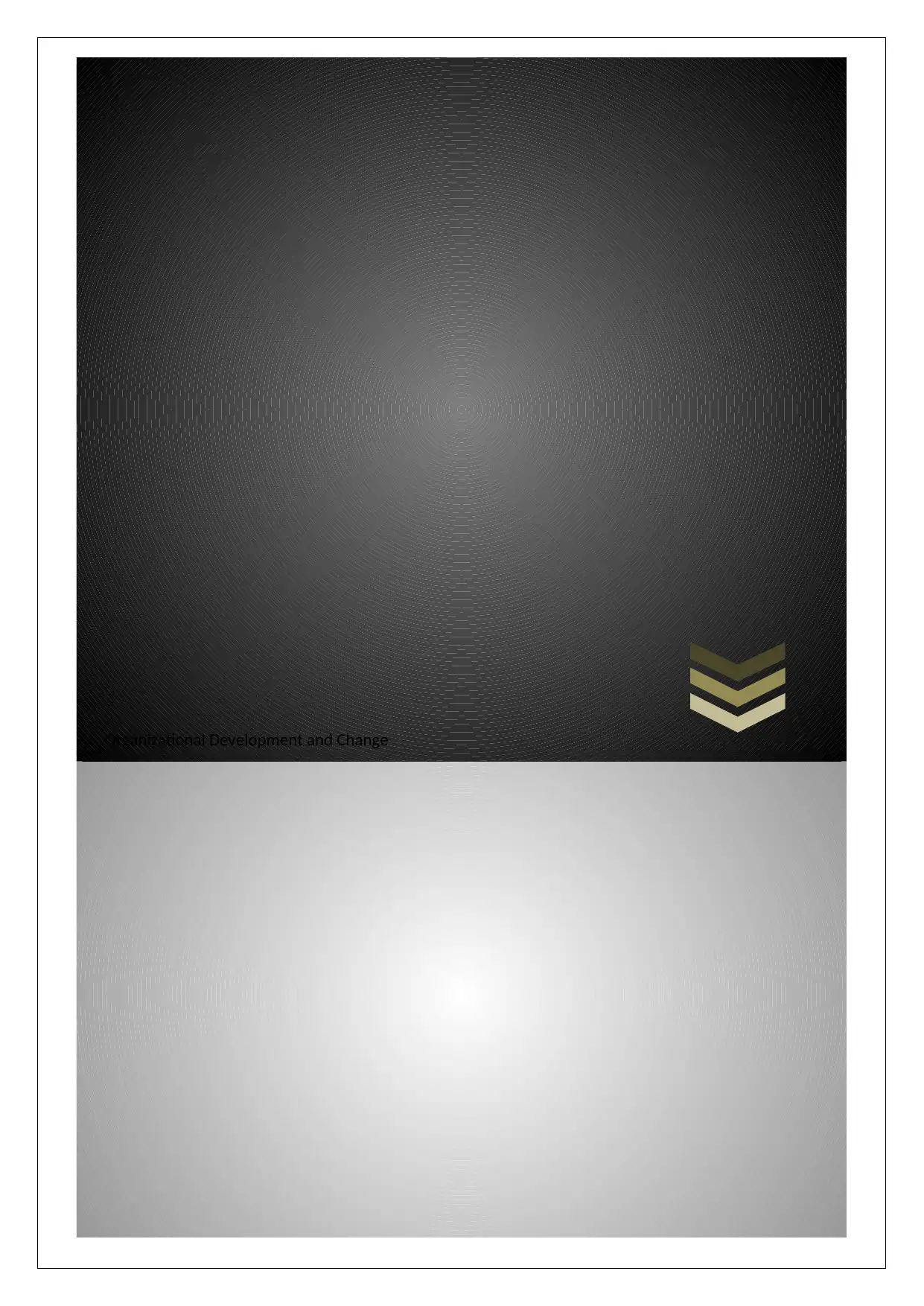
Organizational Development and Change
Paraphrase This Document
Need a fresh take? Get an instant paraphrase of this document with our AI Paraphraser
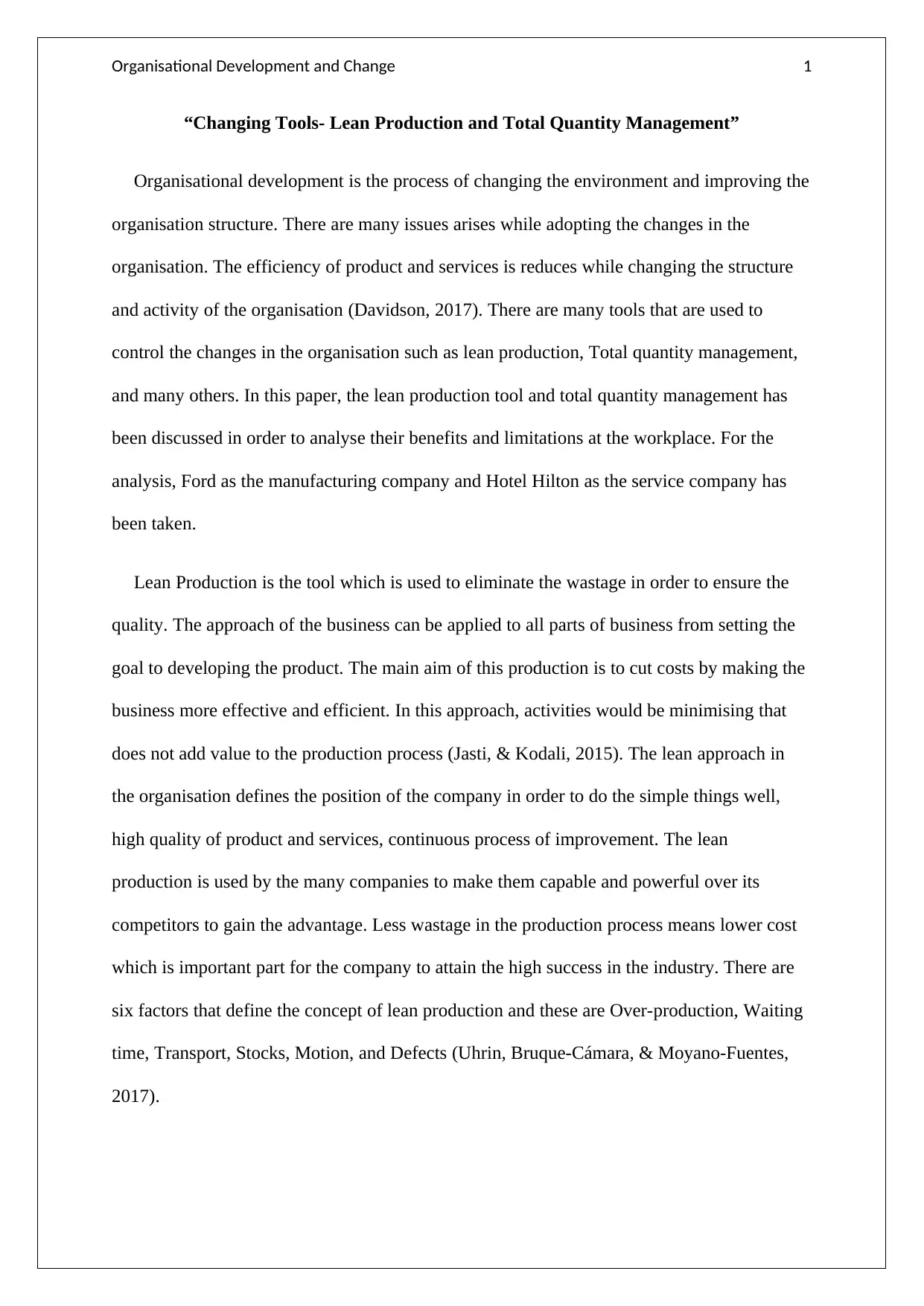
Organisational Development and Change 1
“Changing Tools- Lean Production and Total Quantity Management”
Organisational development is the process of changing the environment and improving the
organisation structure. There are many issues arises while adopting the changes in the
organisation. The efficiency of product and services is reduces while changing the structure
and activity of the organisation (Davidson, 2017). There are many tools that are used to
control the changes in the organisation such as lean production, Total quantity management,
and many others. In this paper, the lean production tool and total quantity management has
been discussed in order to analyse their benefits and limitations at the workplace. For the
analysis, Ford as the manufacturing company and Hotel Hilton as the service company has
been taken.
Lean Production is the tool which is used to eliminate the wastage in order to ensure the
quality. The approach of the business can be applied to all parts of business from setting the
goal to developing the product. The main aim of this production is to cut costs by making the
business more effective and efficient. In this approach, activities would be minimising that
does not add value to the production process (Jasti, & Kodali, 2015). The lean approach in
the organisation defines the position of the company in order to do the simple things well,
high quality of product and services, continuous process of improvement. The lean
production is used by the many companies to make them capable and powerful over its
competitors to gain the advantage. Less wastage in the production process means lower cost
which is important part for the company to attain the high success in the industry. There are
six factors that define the concept of lean production and these are Over-production, Waiting
time, Transport, Stocks, Motion, and Defects (Uhrin, Bruque-Cámara, & Moyano-Fuentes,
2017).
“Changing Tools- Lean Production and Total Quantity Management”
Organisational development is the process of changing the environment and improving the
organisation structure. There are many issues arises while adopting the changes in the
organisation. The efficiency of product and services is reduces while changing the structure
and activity of the organisation (Davidson, 2017). There are many tools that are used to
control the changes in the organisation such as lean production, Total quantity management,
and many others. In this paper, the lean production tool and total quantity management has
been discussed in order to analyse their benefits and limitations at the workplace. For the
analysis, Ford as the manufacturing company and Hotel Hilton as the service company has
been taken.
Lean Production is the tool which is used to eliminate the wastage in order to ensure the
quality. The approach of the business can be applied to all parts of business from setting the
goal to developing the product. The main aim of this production is to cut costs by making the
business more effective and efficient. In this approach, activities would be minimising that
does not add value to the production process (Jasti, & Kodali, 2015). The lean approach in
the organisation defines the position of the company in order to do the simple things well,
high quality of product and services, continuous process of improvement. The lean
production is used by the many companies to make them capable and powerful over its
competitors to gain the advantage. Less wastage in the production process means lower cost
which is important part for the company to attain the high success in the industry. There are
six factors that define the concept of lean production and these are Over-production, Waiting
time, Transport, Stocks, Motion, and Defects (Uhrin, Bruque-Cámara, & Moyano-Fuentes,
2017).
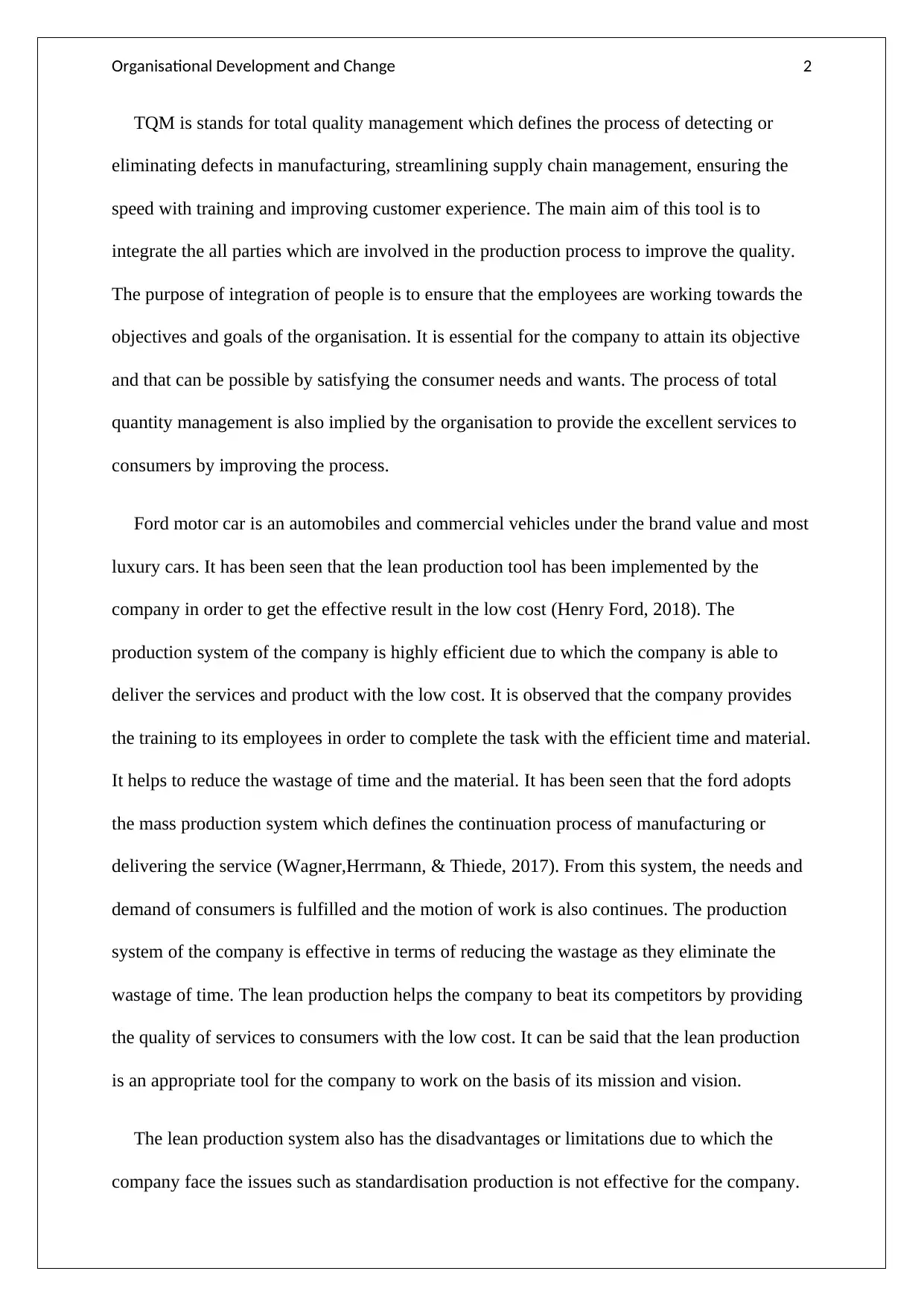
Organisational Development and Change 2
TQM is stands for total quality management which defines the process of detecting or
eliminating defects in manufacturing, streamlining supply chain management, ensuring the
speed with training and improving customer experience. The main aim of this tool is to
integrate the all parties which are involved in the production process to improve the quality.
The purpose of integration of people is to ensure that the employees are working towards the
objectives and goals of the organisation. It is essential for the company to attain its objective
and that can be possible by satisfying the consumer needs and wants. The process of total
quantity management is also implied by the organisation to provide the excellent services to
consumers by improving the process.
Ford motor car is an automobiles and commercial vehicles under the brand value and most
luxury cars. It has been seen that the lean production tool has been implemented by the
company in order to get the effective result in the low cost (Henry Ford, 2018). The
production system of the company is highly efficient due to which the company is able to
deliver the services and product with the low cost. It is observed that the company provides
the training to its employees in order to complete the task with the efficient time and material.
It helps to reduce the wastage of time and the material. It has been seen that the ford adopts
the mass production system which defines the continuation process of manufacturing or
delivering the service (Wagner,Herrmann, & Thiede, 2017). From this system, the needs and
demand of consumers is fulfilled and the motion of work is also continues. The production
system of the company is effective in terms of reducing the wastage as they eliminate the
wastage of time. The lean production helps the company to beat its competitors by providing
the quality of services to consumers with the low cost. It can be said that the lean production
is an appropriate tool for the company to work on the basis of its mission and vision.
The lean production system also has the disadvantages or limitations due to which the
company face the issues such as standardisation production is not effective for the company.
TQM is stands for total quality management which defines the process of detecting or
eliminating defects in manufacturing, streamlining supply chain management, ensuring the
speed with training and improving customer experience. The main aim of this tool is to
integrate the all parties which are involved in the production process to improve the quality.
The purpose of integration of people is to ensure that the employees are working towards the
objectives and goals of the organisation. It is essential for the company to attain its objective
and that can be possible by satisfying the consumer needs and wants. The process of total
quantity management is also implied by the organisation to provide the excellent services to
consumers by improving the process.
Ford motor car is an automobiles and commercial vehicles under the brand value and most
luxury cars. It has been seen that the lean production tool has been implemented by the
company in order to get the effective result in the low cost (Henry Ford, 2018). The
production system of the company is highly efficient due to which the company is able to
deliver the services and product with the low cost. It is observed that the company provides
the training to its employees in order to complete the task with the efficient time and material.
It helps to reduce the wastage of time and the material. It has been seen that the ford adopts
the mass production system which defines the continuation process of manufacturing or
delivering the service (Wagner,Herrmann, & Thiede, 2017). From this system, the needs and
demand of consumers is fulfilled and the motion of work is also continues. The production
system of the company is effective in terms of reducing the wastage as they eliminate the
wastage of time. The lean production helps the company to beat its competitors by providing
the quality of services to consumers with the low cost. It can be said that the lean production
is an appropriate tool for the company to work on the basis of its mission and vision.
The lean production system also has the disadvantages or limitations due to which the
company face the issues such as standardisation production is not effective for the company.
⊘ This is a preview!⊘
Do you want full access?
Subscribe today to unlock all pages.

Trusted by 1+ million students worldwide
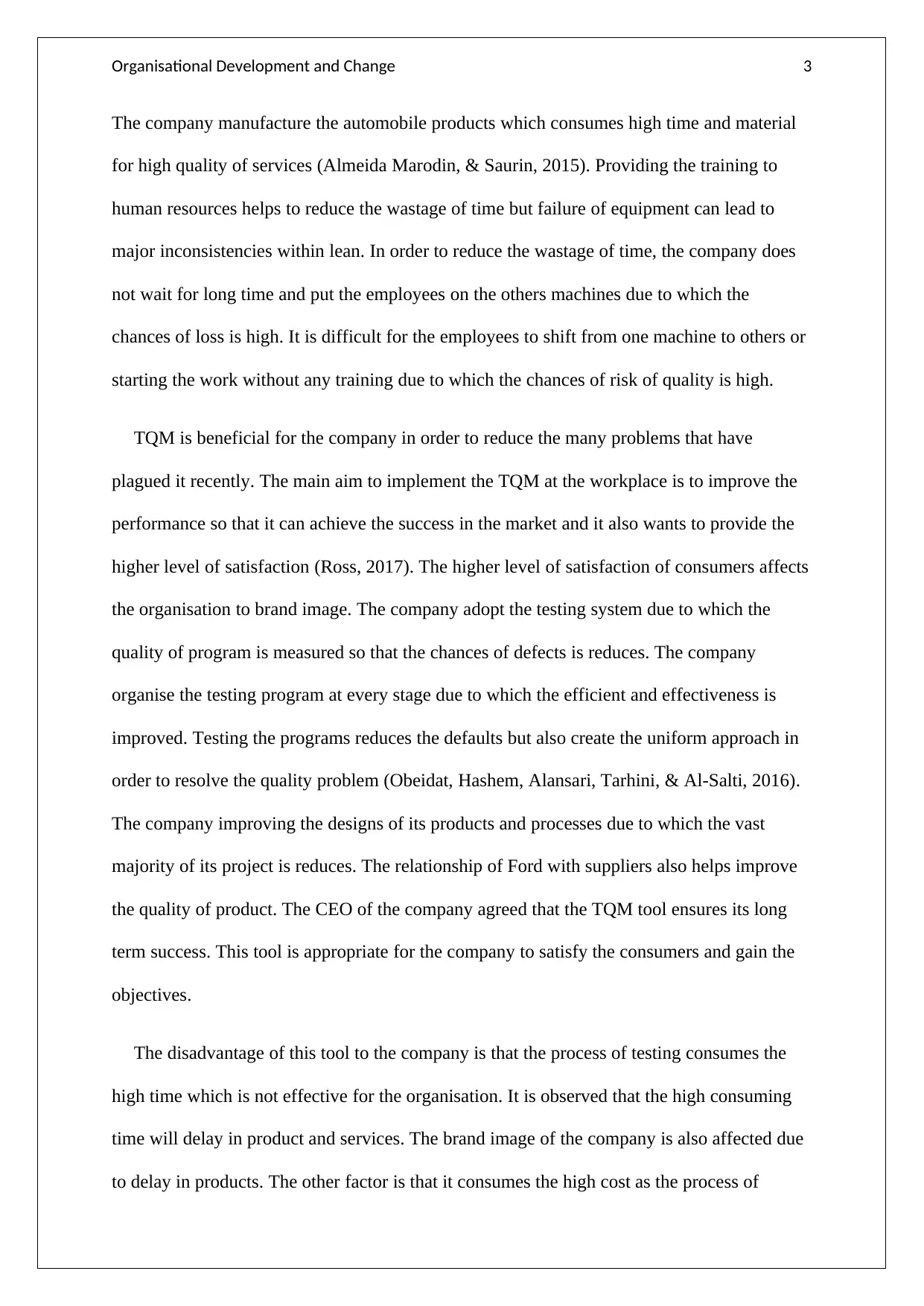
Organisational Development and Change 3
The company manufacture the automobile products which consumes high time and material
for high quality of services (Almeida Marodin, & Saurin, 2015). Providing the training to
human resources helps to reduce the wastage of time but failure of equipment can lead to
major inconsistencies within lean. In order to reduce the wastage of time, the company does
not wait for long time and put the employees on the others machines due to which the
chances of loss is high. It is difficult for the employees to shift from one machine to others or
starting the work without any training due to which the chances of risk of quality is high.
TQM is beneficial for the company in order to reduce the many problems that have
plagued it recently. The main aim to implement the TQM at the workplace is to improve the
performance so that it can achieve the success in the market and it also wants to provide the
higher level of satisfaction (Ross, 2017). The higher level of satisfaction of consumers affects
the organisation to brand image. The company adopt the testing system due to which the
quality of program is measured so that the chances of defects is reduces. The company
organise the testing program at every stage due to which the efficient and effectiveness is
improved. Testing the programs reduces the defaults but also create the uniform approach in
order to resolve the quality problem (Obeidat, Hashem, Alansari, Tarhini, & Al-Salti, 2016).
The company improving the designs of its products and processes due to which the vast
majority of its project is reduces. The relationship of Ford with suppliers also helps improve
the quality of product. The CEO of the company agreed that the TQM tool ensures its long
term success. This tool is appropriate for the company to satisfy the consumers and gain the
objectives.
The disadvantage of this tool to the company is that the process of testing consumes the
high time which is not effective for the organisation. It is observed that the high consuming
time will delay in product and services. The brand image of the company is also affected due
to delay in products. The other factor is that it consumes the high cost as the process of
The company manufacture the automobile products which consumes high time and material
for high quality of services (Almeida Marodin, & Saurin, 2015). Providing the training to
human resources helps to reduce the wastage of time but failure of equipment can lead to
major inconsistencies within lean. In order to reduce the wastage of time, the company does
not wait for long time and put the employees on the others machines due to which the
chances of loss is high. It is difficult for the employees to shift from one machine to others or
starting the work without any training due to which the chances of risk of quality is high.
TQM is beneficial for the company in order to reduce the many problems that have
plagued it recently. The main aim to implement the TQM at the workplace is to improve the
performance so that it can achieve the success in the market and it also wants to provide the
higher level of satisfaction (Ross, 2017). The higher level of satisfaction of consumers affects
the organisation to brand image. The company adopt the testing system due to which the
quality of program is measured so that the chances of defects is reduces. The company
organise the testing program at every stage due to which the efficient and effectiveness is
improved. Testing the programs reduces the defaults but also create the uniform approach in
order to resolve the quality problem (Obeidat, Hashem, Alansari, Tarhini, & Al-Salti, 2016).
The company improving the designs of its products and processes due to which the vast
majority of its project is reduces. The relationship of Ford with suppliers also helps improve
the quality of product. The CEO of the company agreed that the TQM tool ensures its long
term success. This tool is appropriate for the company to satisfy the consumers and gain the
objectives.
The disadvantage of this tool to the company is that the process of testing consumes the
high time which is not effective for the organisation. It is observed that the high consuming
time will delay in product and services. The brand image of the company is also affected due
to delay in products. The other factor is that it consumes the high cost as the process of
Paraphrase This Document
Need a fresh take? Get an instant paraphrase of this document with our AI Paraphraser
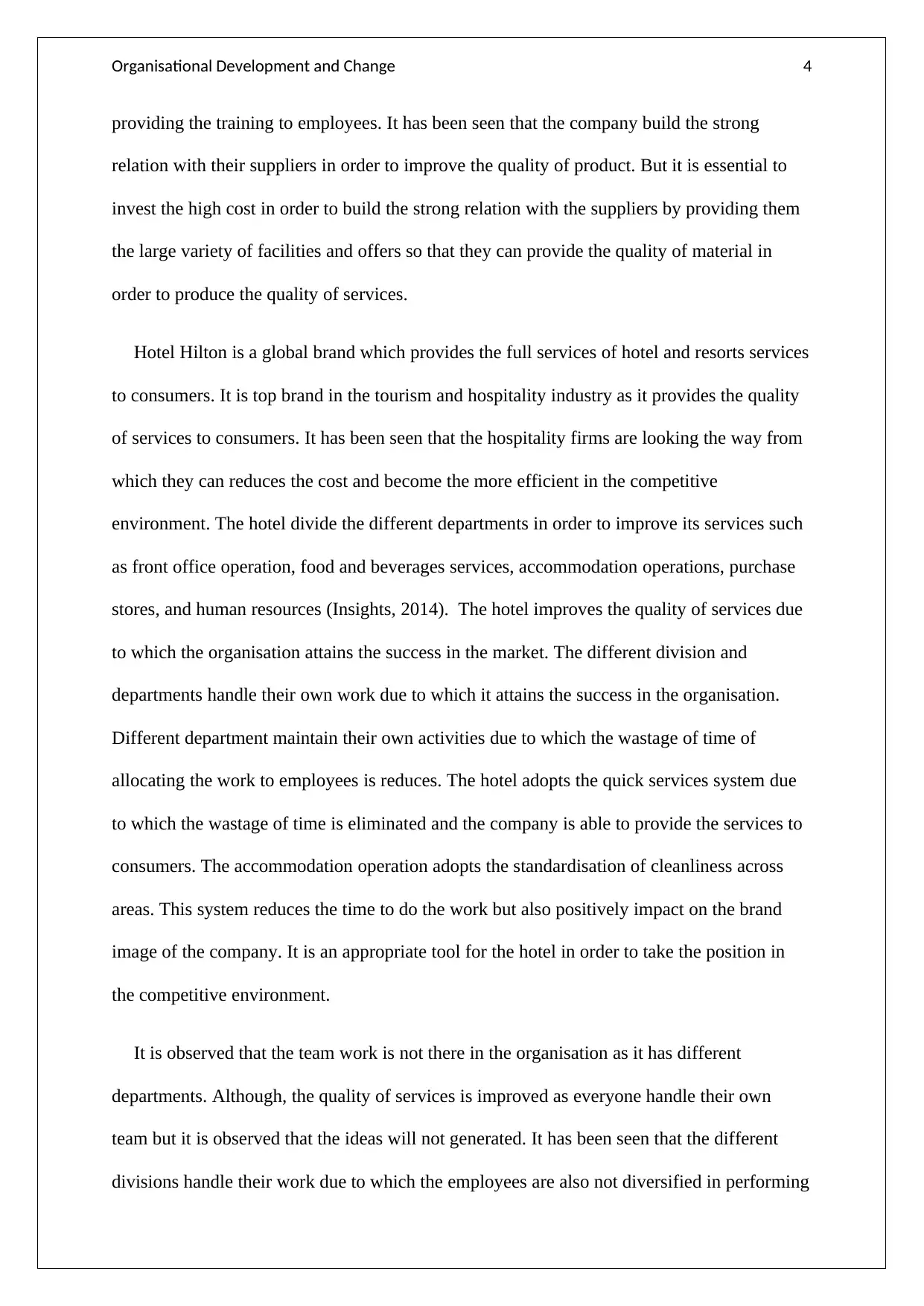
Organisational Development and Change 4
providing the training to employees. It has been seen that the company build the strong
relation with their suppliers in order to improve the quality of product. But it is essential to
invest the high cost in order to build the strong relation with the suppliers by providing them
the large variety of facilities and offers so that they can provide the quality of material in
order to produce the quality of services.
Hotel Hilton is a global brand which provides the full services of hotel and resorts services
to consumers. It is top brand in the tourism and hospitality industry as it provides the quality
of services to consumers. It has been seen that the hospitality firms are looking the way from
which they can reduces the cost and become the more efficient in the competitive
environment. The hotel divide the different departments in order to improve its services such
as front office operation, food and beverages services, accommodation operations, purchase
stores, and human resources (Insights, 2014). The hotel improves the quality of services due
to which the organisation attains the success in the market. The different division and
departments handle their own work due to which it attains the success in the organisation.
Different department maintain their own activities due to which the wastage of time of
allocating the work to employees is reduces. The hotel adopts the quick services system due
to which the wastage of time is eliminated and the company is able to provide the services to
consumers. The accommodation operation adopts the standardisation of cleanliness across
areas. This system reduces the time to do the work but also positively impact on the brand
image of the company. It is an appropriate tool for the hotel in order to take the position in
the competitive environment.
It is observed that the team work is not there in the organisation as it has different
departments. Although, the quality of services is improved as everyone handle their own
team but it is observed that the ideas will not generated. It has been seen that the different
divisions handle their work due to which the employees are also not diversified in performing
providing the training to employees. It has been seen that the company build the strong
relation with their suppliers in order to improve the quality of product. But it is essential to
invest the high cost in order to build the strong relation with the suppliers by providing them
the large variety of facilities and offers so that they can provide the quality of material in
order to produce the quality of services.
Hotel Hilton is a global brand which provides the full services of hotel and resorts services
to consumers. It is top brand in the tourism and hospitality industry as it provides the quality
of services to consumers. It has been seen that the hospitality firms are looking the way from
which they can reduces the cost and become the more efficient in the competitive
environment. The hotel divide the different departments in order to improve its services such
as front office operation, food and beverages services, accommodation operations, purchase
stores, and human resources (Insights, 2014). The hotel improves the quality of services due
to which the organisation attains the success in the market. The different division and
departments handle their own work due to which it attains the success in the organisation.
Different department maintain their own activities due to which the wastage of time of
allocating the work to employees is reduces. The hotel adopts the quick services system due
to which the wastage of time is eliminated and the company is able to provide the services to
consumers. The accommodation operation adopts the standardisation of cleanliness across
areas. This system reduces the time to do the work but also positively impact on the brand
image of the company. It is an appropriate tool for the hotel in order to take the position in
the competitive environment.
It is observed that the team work is not there in the organisation as it has different
departments. Although, the quality of services is improved as everyone handle their own
team but it is observed that the ideas will not generated. It has been seen that the different
divisions handle their work due to which the employees are also not diversified in performing
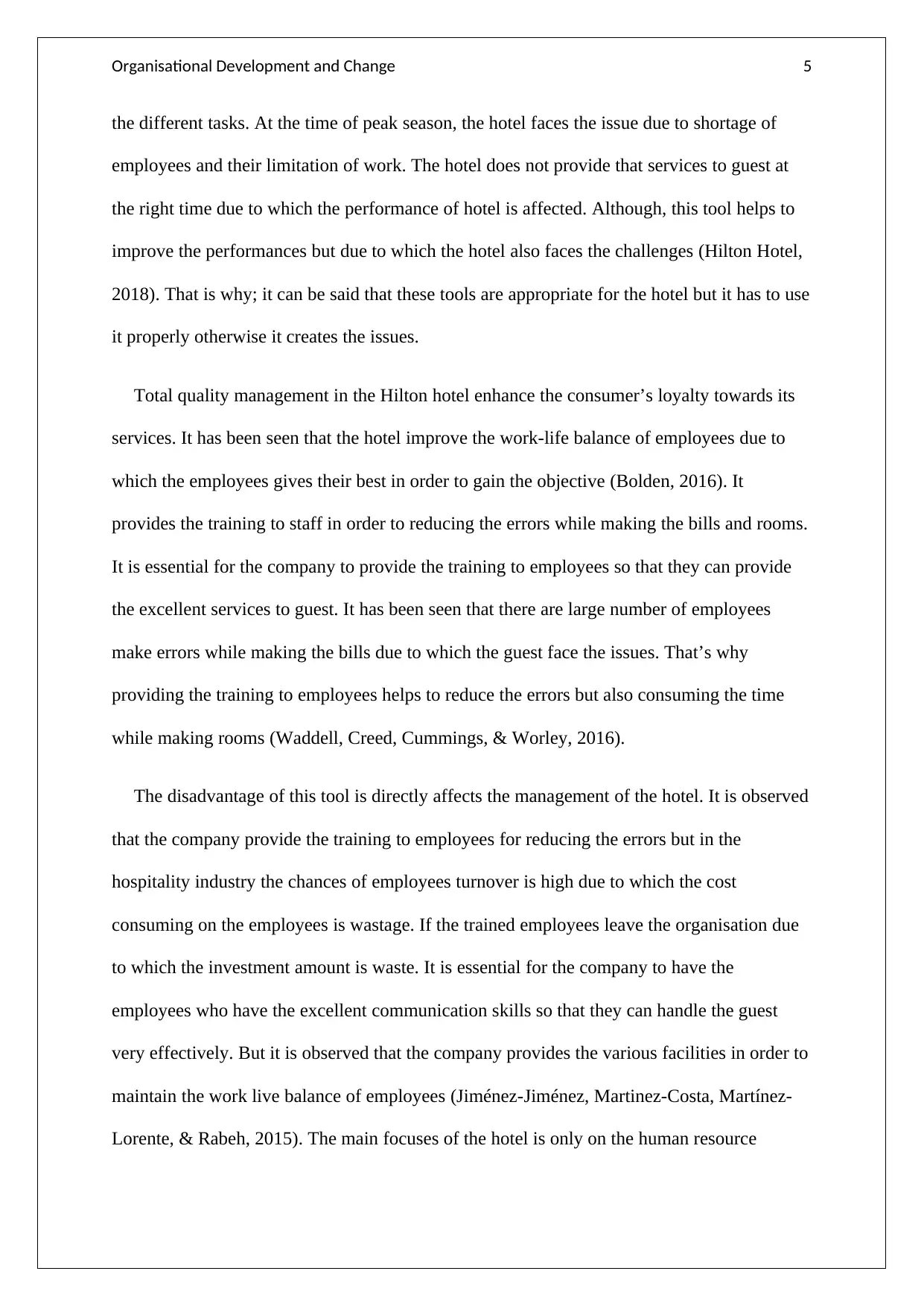
Organisational Development and Change 5
the different tasks. At the time of peak season, the hotel faces the issue due to shortage of
employees and their limitation of work. The hotel does not provide that services to guest at
the right time due to which the performance of hotel is affected. Although, this tool helps to
improve the performances but due to which the hotel also faces the challenges (Hilton Hotel,
2018). That is why; it can be said that these tools are appropriate for the hotel but it has to use
it properly otherwise it creates the issues.
Total quality management in the Hilton hotel enhance the consumer’s loyalty towards its
services. It has been seen that the hotel improve the work-life balance of employees due to
which the employees gives their best in order to gain the objective (Bolden, 2016). It
provides the training to staff in order to reducing the errors while making the bills and rooms.
It is essential for the company to provide the training to employees so that they can provide
the excellent services to guest. It has been seen that there are large number of employees
make errors while making the bills due to which the guest face the issues. That’s why
providing the training to employees helps to reduce the errors but also consuming the time
while making rooms (Waddell, Creed, Cummings, & Worley, 2016).
The disadvantage of this tool is directly affects the management of the hotel. It is observed
that the company provide the training to employees for reducing the errors but in the
hospitality industry the chances of employees turnover is high due to which the cost
consuming on the employees is wastage. If the trained employees leave the organisation due
to which the investment amount is waste. It is essential for the company to have the
employees who have the excellent communication skills so that they can handle the guest
very effectively. But it is observed that the company provides the various facilities in order to
maintain the work live balance of employees (Jiménez-Jiménez, Martinez-Costa, Martínez-
Lorente, & Rabeh, 2015). The main focuses of the hotel is only on the human resource
the different tasks. At the time of peak season, the hotel faces the issue due to shortage of
employees and their limitation of work. The hotel does not provide that services to guest at
the right time due to which the performance of hotel is affected. Although, this tool helps to
improve the performances but due to which the hotel also faces the challenges (Hilton Hotel,
2018). That is why; it can be said that these tools are appropriate for the hotel but it has to use
it properly otherwise it creates the issues.
Total quality management in the Hilton hotel enhance the consumer’s loyalty towards its
services. It has been seen that the hotel improve the work-life balance of employees due to
which the employees gives their best in order to gain the objective (Bolden, 2016). It
provides the training to staff in order to reducing the errors while making the bills and rooms.
It is essential for the company to provide the training to employees so that they can provide
the excellent services to guest. It has been seen that there are large number of employees
make errors while making the bills due to which the guest face the issues. That’s why
providing the training to employees helps to reduce the errors but also consuming the time
while making rooms (Waddell, Creed, Cummings, & Worley, 2016).
The disadvantage of this tool is directly affects the management of the hotel. It is observed
that the company provide the training to employees for reducing the errors but in the
hospitality industry the chances of employees turnover is high due to which the cost
consuming on the employees is wastage. If the trained employees leave the organisation due
to which the investment amount is waste. It is essential for the company to have the
employees who have the excellent communication skills so that they can handle the guest
very effectively. But it is observed that the company provides the various facilities in order to
maintain the work live balance of employees (Jiménez-Jiménez, Martinez-Costa, Martínez-
Lorente, & Rabeh, 2015). The main focuses of the hotel is only on the human resource
⊘ This is a preview!⊘
Do you want full access?
Subscribe today to unlock all pages.

Trusted by 1+ million students worldwide
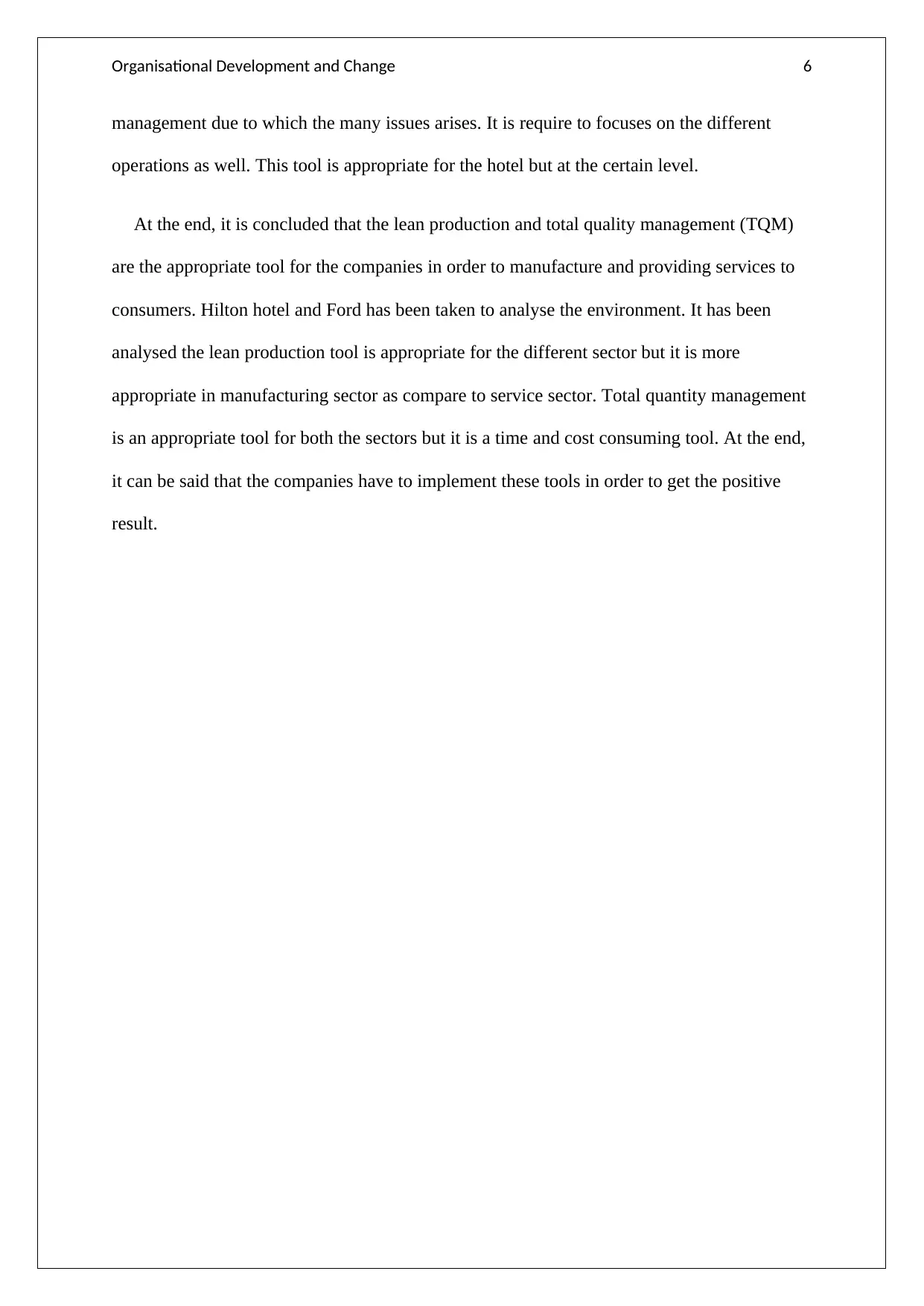
Organisational Development and Change 6
management due to which the many issues arises. It is require to focuses on the different
operations as well. This tool is appropriate for the hotel but at the certain level.
At the end, it is concluded that the lean production and total quality management (TQM)
are the appropriate tool for the companies in order to manufacture and providing services to
consumers. Hilton hotel and Ford has been taken to analyse the environment. It has been
analysed the lean production tool is appropriate for the different sector but it is more
appropriate in manufacturing sector as compare to service sector. Total quantity management
is an appropriate tool for both the sectors but it is a time and cost consuming tool. At the end,
it can be said that the companies have to implement these tools in order to get the positive
result.
management due to which the many issues arises. It is require to focuses on the different
operations as well. This tool is appropriate for the hotel but at the certain level.
At the end, it is concluded that the lean production and total quality management (TQM)
are the appropriate tool for the companies in order to manufacture and providing services to
consumers. Hilton hotel and Ford has been taken to analyse the environment. It has been
analysed the lean production tool is appropriate for the different sector but it is more
appropriate in manufacturing sector as compare to service sector. Total quantity management
is an appropriate tool for both the sectors but it is a time and cost consuming tool. At the end,
it can be said that the companies have to implement these tools in order to get the positive
result.
Paraphrase This Document
Need a fresh take? Get an instant paraphrase of this document with our AI Paraphraser
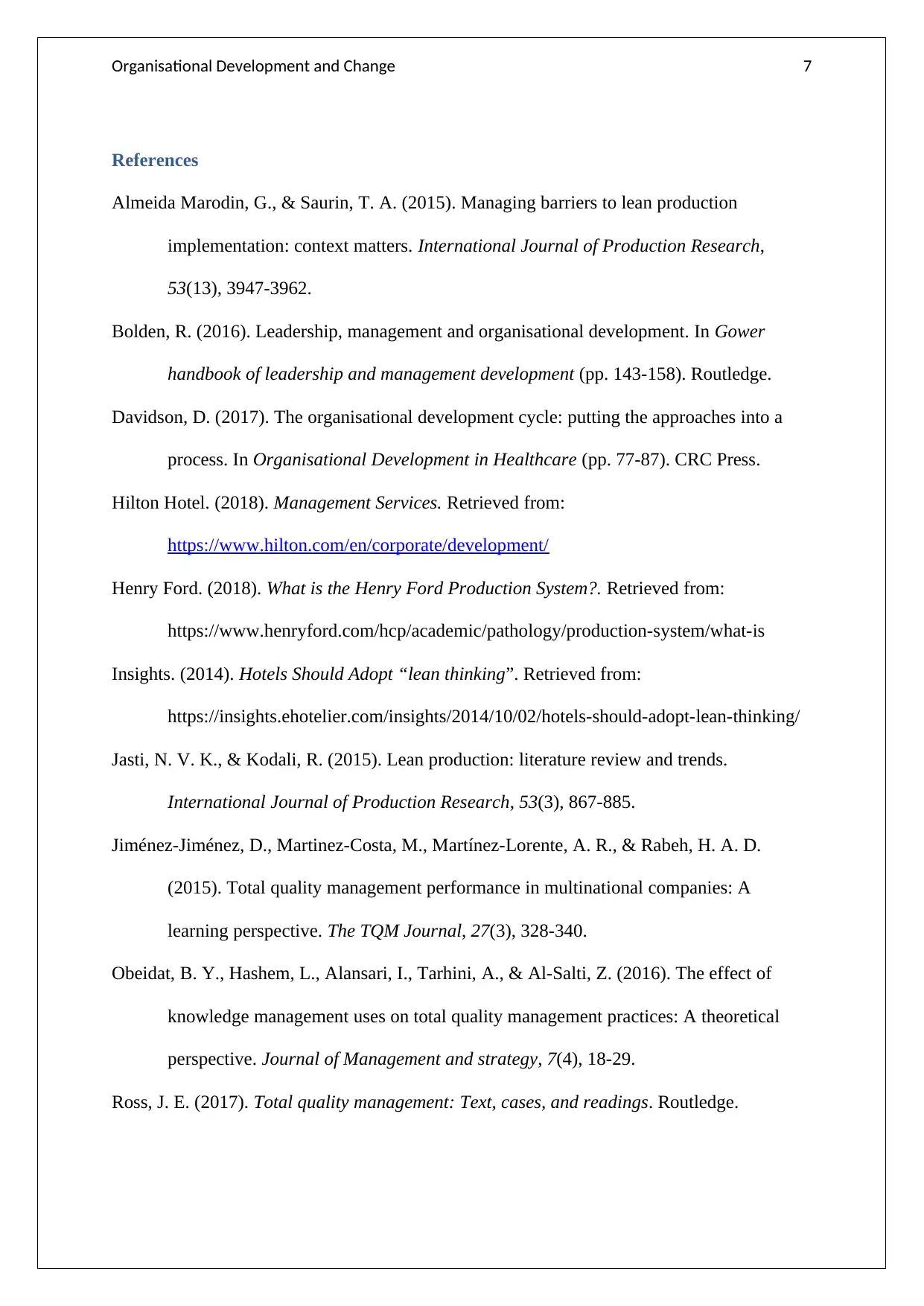
Organisational Development and Change 7
References
Almeida Marodin, G., & Saurin, T. A. (2015). Managing barriers to lean production
implementation: context matters. International Journal of Production Research,
53(13), 3947-3962.
Bolden, R. (2016). Leadership, management and organisational development. In Gower
handbook of leadership and management development (pp. 143-158). Routledge.
Davidson, D. (2017). The organisational development cycle: putting the approaches into a
process. In Organisational Development in Healthcare (pp. 77-87). CRC Press.
Hilton Hotel. (2018). Management Services. Retrieved from:
https://www.hilton.com/en/corporate/development/
Henry Ford. (2018). What is the Henry Ford Production System?. Retrieved from:
https://www.henryford.com/hcp/academic/pathology/production-system/what-is
Insights. (2014). Hotels Should Adopt “lean thinking”. Retrieved from:
https://insights.ehotelier.com/insights/2014/10/02/hotels-should-adopt-lean-thinking/
Jasti, N. V. K., & Kodali, R. (2015). Lean production: literature review and trends.
International Journal of Production Research, 53(3), 867-885.
Jiménez-Jiménez, D., Martinez-Costa, M., Martínez-Lorente, A. R., & Rabeh, H. A. D.
(2015). Total quality management performance in multinational companies: A
learning perspective. The TQM Journal, 27(3), 328-340.
Obeidat, B. Y., Hashem, L., Alansari, I., Tarhini, A., & Al-Salti, Z. (2016). The effect of
knowledge management uses on total quality management practices: A theoretical
perspective. Journal of Management and strategy, 7(4), 18-29.
Ross, J. E. (2017). Total quality management: Text, cases, and readings. Routledge.
References
Almeida Marodin, G., & Saurin, T. A. (2015). Managing barriers to lean production
implementation: context matters. International Journal of Production Research,
53(13), 3947-3962.
Bolden, R. (2016). Leadership, management and organisational development. In Gower
handbook of leadership and management development (pp. 143-158). Routledge.
Davidson, D. (2017). The organisational development cycle: putting the approaches into a
process. In Organisational Development in Healthcare (pp. 77-87). CRC Press.
Hilton Hotel. (2018). Management Services. Retrieved from:
https://www.hilton.com/en/corporate/development/
Henry Ford. (2018). What is the Henry Ford Production System?. Retrieved from:
https://www.henryford.com/hcp/academic/pathology/production-system/what-is
Insights. (2014). Hotels Should Adopt “lean thinking”. Retrieved from:
https://insights.ehotelier.com/insights/2014/10/02/hotels-should-adopt-lean-thinking/
Jasti, N. V. K., & Kodali, R. (2015). Lean production: literature review and trends.
International Journal of Production Research, 53(3), 867-885.
Jiménez-Jiménez, D., Martinez-Costa, M., Martínez-Lorente, A. R., & Rabeh, H. A. D.
(2015). Total quality management performance in multinational companies: A
learning perspective. The TQM Journal, 27(3), 328-340.
Obeidat, B. Y., Hashem, L., Alansari, I., Tarhini, A., & Al-Salti, Z. (2016). The effect of
knowledge management uses on total quality management practices: A theoretical
perspective. Journal of Management and strategy, 7(4), 18-29.
Ross, J. E. (2017). Total quality management: Text, cases, and readings. Routledge.
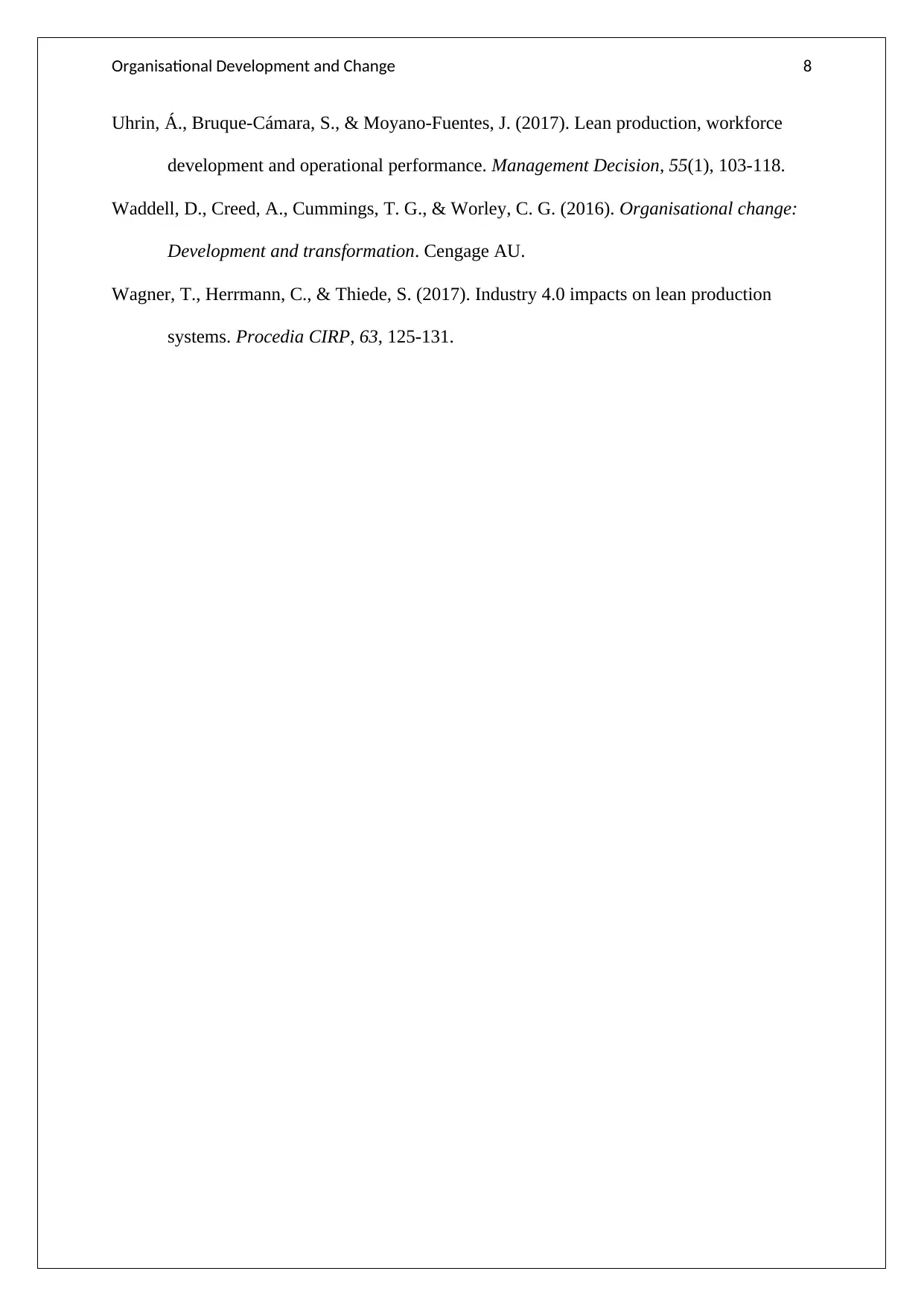
Organisational Development and Change 8
Uhrin, Á., Bruque-Cámara, S., & Moyano-Fuentes, J. (2017). Lean production, workforce
development and operational performance. Management Decision, 55(1), 103-118.
Waddell, D., Creed, A., Cummings, T. G., & Worley, C. G. (2016). Organisational change:
Development and transformation. Cengage AU.
Wagner, T., Herrmann, C., & Thiede, S. (2017). Industry 4.0 impacts on lean production
systems. Procedia CIRP, 63, 125-131.
Uhrin, Á., Bruque-Cámara, S., & Moyano-Fuentes, J. (2017). Lean production, workforce
development and operational performance. Management Decision, 55(1), 103-118.
Waddell, D., Creed, A., Cummings, T. G., & Worley, C. G. (2016). Organisational change:
Development and transformation. Cengage AU.
Wagner, T., Herrmann, C., & Thiede, S. (2017). Industry 4.0 impacts on lean production
systems. Procedia CIRP, 63, 125-131.
⊘ This is a preview!⊘
Do you want full access?
Subscribe today to unlock all pages.

Trusted by 1+ million students worldwide
1 out of 9
Related Documents
Your All-in-One AI-Powered Toolkit for Academic Success.
+13062052269
info@desklib.com
Available 24*7 on WhatsApp / Email
![[object Object]](/_next/static/media/star-bottom.7253800d.svg)
Unlock your academic potential
Copyright © 2020–2025 A2Z Services. All Rights Reserved. Developed and managed by ZUCOL.




